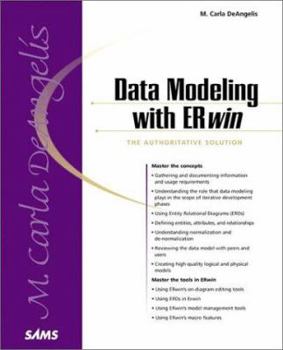Data Modeling with Erwin
From the first chapter, author Carla DeAngelis skillfully explains the normally complex concepts of Data Modeling-a critical success factor in the information-based enterprises of today. Carla tackles... This description may be from another edition of this product.
Format:Paperback
Language:English
ISBN:0672318687
ISBN13:9780672318689
Release Date:January 2000
Publisher:Sams Publishing
Length:410 Pages
Weight:1.64 lbs.
Dimensions:0.9" x 7.2" x 9.3"
Customer Reviews
5 ratings
Data Modeling with ERwin
Published by Thriftbooks.com User , 17 years ago
Excellent service. Received item on time Item is very good condition. Thanks
A great starter book
Published by Thriftbooks.com User , 18 years ago
I agree with the concensus reccomendation, this is a primer. Buy this book to get a 10,000 ft view of the data modeling plateu and a short overview of ERwin. It worked perfectly for me as I was a novice to both modeling and the CA tool.
A useful primer for ERwin
Published by Thriftbooks.com User , 24 years ago
While I have to agree with some earlier reviews that criticize the book for not being a complete reference, I found it far more useful than the LogicWorks/Platinum manuals as a guide to getting started and developing an intelligent approach to getting work done using ERwin. Ms. De Angelis has a clear writing style and does not hesitate to tell the reader how she thinks things should be done. She spends a good bit of time in explaining the fundamentals of data modeling, which is appropriate and useful for the book's intended audience. Not expensive, and probably a good investment for someone trying to get up to speed or who has used the product for a while and would like some guidance in how to use it more effectively.
Needs more Tips and Techniques
Published by Thriftbooks.com User , 24 years ago
Considering the thousands you'll spend on data modeling tools and the tens of thousands on salaries, you can't go too far wrong by spending...on a book about a data modeling tool."Data Modeling with Erwin" is a hybrid between a data modeling text and one of those "MS-Word for Dummies" books which shows all the dialog boxes in an application and explains what they mean. It does a fine job in both explaining data modeling as well as walking through the Erwin's features.That said, I was hoping for much more "real world" tips and techniques from this book, i.e. more practice to supplement the theory. Specifically, I would have been interested in best practices for use of "subject areas," and "stored displays." Is there a defacto standard on these things? Also, I would have been interested in some simple guidelines for keeping your model (i.e. the main subject area) "clean looking" when your application has 100+ tables and more relationships. Another example: the "Reverse Engineering" section could use some guidelines on importing a model from a database (e.g Oracle) into Erwin for subsequent development. Things you should do, avoid, etc. Again, this book might be helpful in the long run. I don't know how it measures up with the Erwin documentation. For me, however, I'll need to pick the hive-mind of the newsgroups for more "real world" advice.p.s. This book also has one too many references such as "Claude Frankenstein, in his book *IE for a New Tomorrow* defines an entity as..." It gets a bit old after a while.p.p.s This book lacks a 'lay-flat' binding, so it's hard to read on your desktop while you're eating lunch.
A good introduction to Logical Data Modelling *and* ERwin.
Published by Thriftbooks.com User , 25 years ago
ERwin users finally have an independent text to use in addition to application documentation. The work's introduction does a clear job of defining the target audience: "_Data Modeling with ERwin_ is intended for use by novice modelers who are interested in producing quality logical and physical data models using ERwin."...and it does a good job on the logical side, along with providing a good walkthough of ERwin, specificly ERwin version 3.5.x. Concepts presented are what I would call generaly accepted practices - many organizations follow them with successful results. There are plenty of screenshots of ERwin, as well as data model examples...and it *doesn't* use the common video store sample data model.Part I, Modeling Concepts, includes a high-level overview of a systems development methdology, albeit of the waterfall approach that is not as popular today. It also covers normalization, a topic that I believe is premature at this point of the work. This overview draws heavily on works by Chen, Finkelstein, and Date.This text includes Best Practices, Tips, and basic functionality of ERwin. It does not address any workarounds for known problems, which I find to be its greatest weakness. However, if you are new to ERwin the Best Practices, Tips, and Cautions will be a valuable and timesaving resource.This book is primarily a Logical Data Modelling resource, but it does cover Physical Data Modelling from the ERwin point of view. Only 89 of the 384 pages of the work are devoted to Physical Modelling.If you are new to data modelling as well as ERwin, you will need additional resources on data modelling to support your new skillset. If you are looking for a resource for managing physical data models and databases, you'll have to rely on ERwin documentation and resources such as the ERwin Users Discussion Group.If you are an experienced data modeller or ERwin user, this book might not add value to your reading....but it would be great to have around as a resource for others: developers working to understand modelling, DBAs who are looking to understand logical data modelling, and project managers wanting to understand why this modelling stuff is taking so long....[g].






